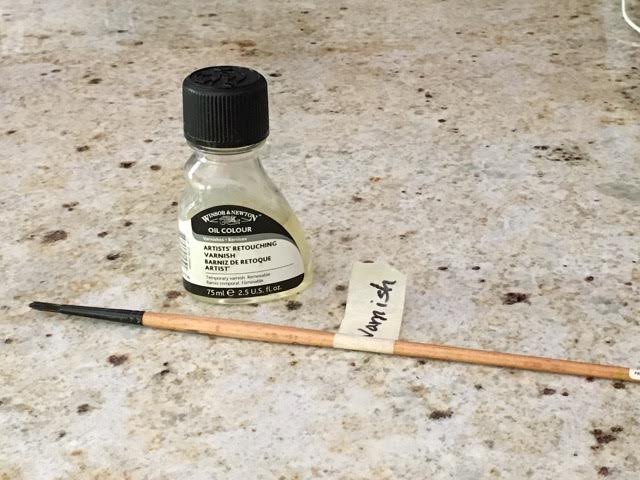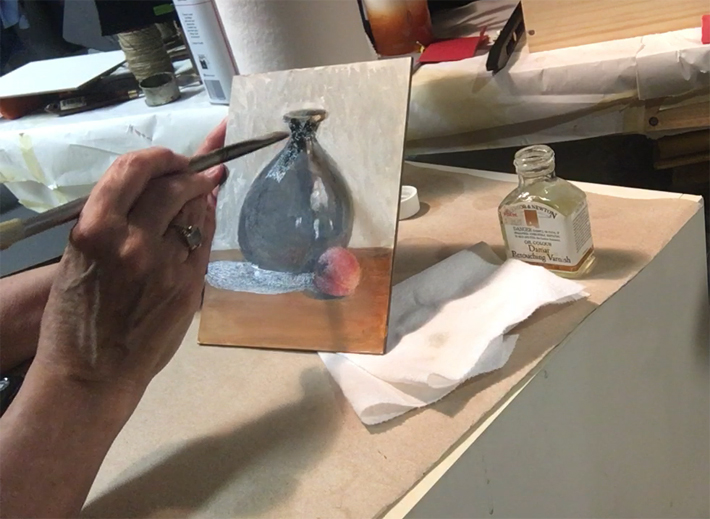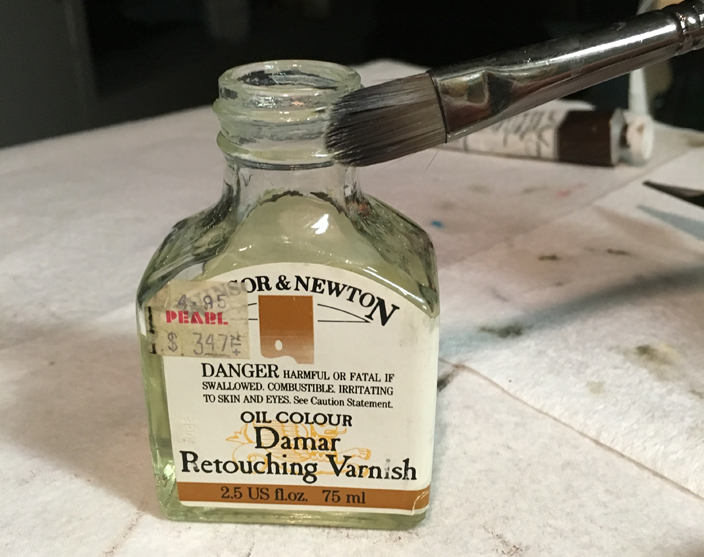
What is varnishing and why do it?
Varnish protects your painting.
The main function of varnish is to protect an oil painting from dirt and atmospheric ravages like, oh, soot (for those of you who still heat with a wood stove like old masters). It’s actually not a trivial concern because any sort of smoke or oils in the air will cling to oil paint and discolor over time. On varnished paintings, the dirt settles on the varnish, not the paint. Carefully removing varnish will also remove dirt, without affecting the artwork.Varnishing gives paintings a shine.
The other function of varnish is to even out the surface shine of dried paint. Often areas of a painting appear dull or matte as they dry. This is called “sinking in,” which refers to the oil content being absorbed into the surface, whether canvas or board. When paint sinks in, the relationship of lights and darks will appear changed. Varnish brings it back to the wet gloss. And since some colors dry glossier than others, varnish can even out the surface overall. For example, alizarin crimson is more glossy than raw umber or ultramarine.Why not varnish?
Varnishing is not technically necessary for a finished painting, but any oil painting with unevenly dull and glossy areas will benefit from applying varnish. Artwork that is for sale and is expected to look good over time is generally varnished for protection. The choice is yours.
Unvarnished painting

Varnished painting
What are the different varnish types?
Traditional varnish
Traditional varnish or finish varnish serves both purposes described above — but ONLY when a painting is thoroughly dry, which can take six months or longer. Oil paint “dries” by oxidation, not evaporation. Varnish seals the surface, preventing oxidation from taking place. The long wait is necessary to be sure under-layers have thoroughly oxidized, otherwise the outer layers of paint risk cracking.Retouch varnish
Retouch varnish is basically a traditional varnish that has been thinned with a solvent. It is not meant to be a final varnish. Retouch varnish should be applied to paint that’s dry to the touch to bring up shine and original depth of color. Evening out the finish in this way makes it easier to rework a section and compare values.How do you apply varnish?
For traditional varnish, first be certain all areas of the painting are at least six months old. For varnishing with retouch varnish in between layers, the paint must be totally dry to the touch. Be especially careful of colors like Alizarin Crimson and Ivory Black, which take a very long time to dry. For either type of varnish, examine the surface closely for specks of dust or fine hairs. If there are any, try lifting them with a fine, dry brush or — very carefully — with the edge of a palette knife. It won’t be easy! If you must wipe with solvent, you’ll have to wait again for it to dry.

Top tips for using varnish
Ventilate!
Varnish is smelly. Those fumes are toxic over time, whether or not they provoke an allergic reaction. Use sparingly and with good ventilation and air movement. In art schools, varnish use is generally relegated to a specially ventilated area. At home, open your windows — even in cold weather.Close the varnish bottle between applications.
Since varnish is sticky, I suggest wiping the outside of the bottle with solvent, taking care to keep the solvent brush away from the top lip so it can’t possibly drip into the varnish.

Your sound like you know your business but unwill to divulge too much information and there things that I have to know before applyingvarnish to one of my paintings